Thursday, February 08 2018
Today was another terrible day for the stock market. The big drop today drove all of the major indices into "Correction" territory (between a -10% and -20% drop). For most of us, it's pretty tough to experience a drop like this over just a few days.
Without trying to figure out how we got into this mess (rising interest rates, inflation worries, overbought markets, etc), let's try to figure out where the market is going from here. Tomorrow's market performance is very important and that is why I designate tomorrow as a "Critical" day (see graph below).
As you can see, the drop in the market since the end of Jan 2018 has been steep and vicious; as it resulted in about a -10% loss for all of the major indices. Thankfully, today's drop in the SPY shown below held just above its "support" level of $257.6/share on both the Long-Term Trend Line and the 150-day EMA. That is why tomorrow's market performance is critical. If this "support" level does not hold, this bull market could be in trouble (at least, short-term). For example, the only thing left to stop this drop now is the 200-day EMA; and I surely do not want to go there.
Of course, these commonly used "indicators" are a very small part of the MIPS models. But, they are interesting to watch, mainly because many other quantitative models rely 100% on several of them (NOT recommened).
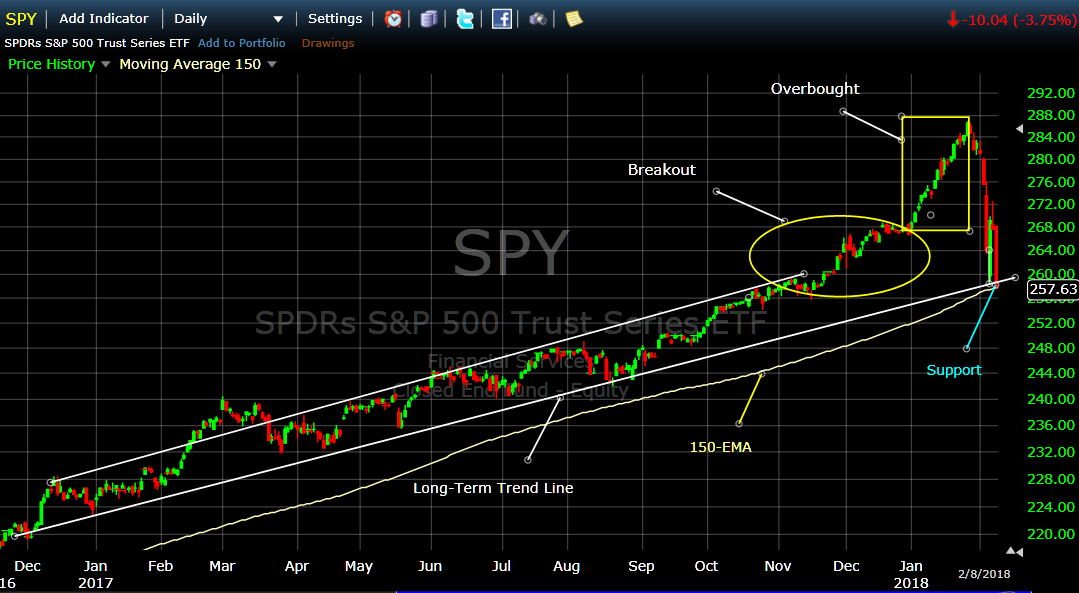
Even though MIPS seems to be on the verge of triggering a Cash or Short signal, anything can happen.
So, stay tuned to MIPS...
Paul Distefano, PhD
MIPS Timing Systems, LLC
Houston, TX
281-251-MIPS(6477)
==================================================================.
<<< Yesterday's MIPS Blog >>>
Wow! What a nerve-racking market we have had in the last few trading days. As of today's date, the S&P 500 is close to "giving back" all of the gains it made in 2018.
Seems like everyone wants to know, "Is this a relatively small "dip" or a big "drop", as in an official correction? Or even, is this the beginning of a full-fledged market crash.
I am very comfortable that MIPS would protect us from the "sting" of a crash (as in 2008, shown below), and I don't believe this is even in the cards at this time. The only "indicator" that I know that works 100% of the time is that market crashes DO NOT happen during strong economies with rising corporate profits. We have both at this time, and expect them to continue.
If I am correct above, this leaves us with either a smallish dip or a correction. If we are in for a smallish dip, this has already happened (-9%) and the market should head back up for a while (for about as long as our economy stays strong). But, we do not want the economy to get overheated, because this will cause the Fed to stick their nose in and screw things up by overreacting (like they almost always do).
I think we all know (or believe) that the two culprits that have caused the fast dip in market prices so far have been the very highly "overbought" market and the Fed's plans for interest rate hikes.
Let's look at the dip in the market a little closer and see how bad it actually has been before we dwell on the reasons for the drop and how we are going to protect our portfolios now (see graph immediately below).
1) From Dec'16 to Nov'17 the SPY moved in a "near perfect" long-term up-channel.
2) In mid-Nov'17, the SPY picked up steam and moved above the upper line in the channel.
3) Between Jan 1, 2018 and Jan 26, 2018 the SPY took off like it was launched like a rocket.
4) Most investors knew this would come to an end, but not when.
5) Almost all pure reversion-to-the-mean models and algorithms were warning to get out; but
trend following models (like MIPS) usually would not trigger a cash or short signal as long
as the SPY remained above the long-term trendline (along with what the other indicators
and algorithms in the model were advising).
As you know (and can see below), the SPY dipped on Jan 29, 2018 and then dropped all the way
down to the long-term trendline on Feb 5th, and bounced back up some on Feb 6th. The SPY held
above the trendline again today (Feb 7th). Most likely, the SPY will again "test" the long-term
trendline; and, of course, it is of utmost importance for the SPY to remain above the trend-line.
Otherwise, look for trouble.
Note: The graph below is using Daily Bars.
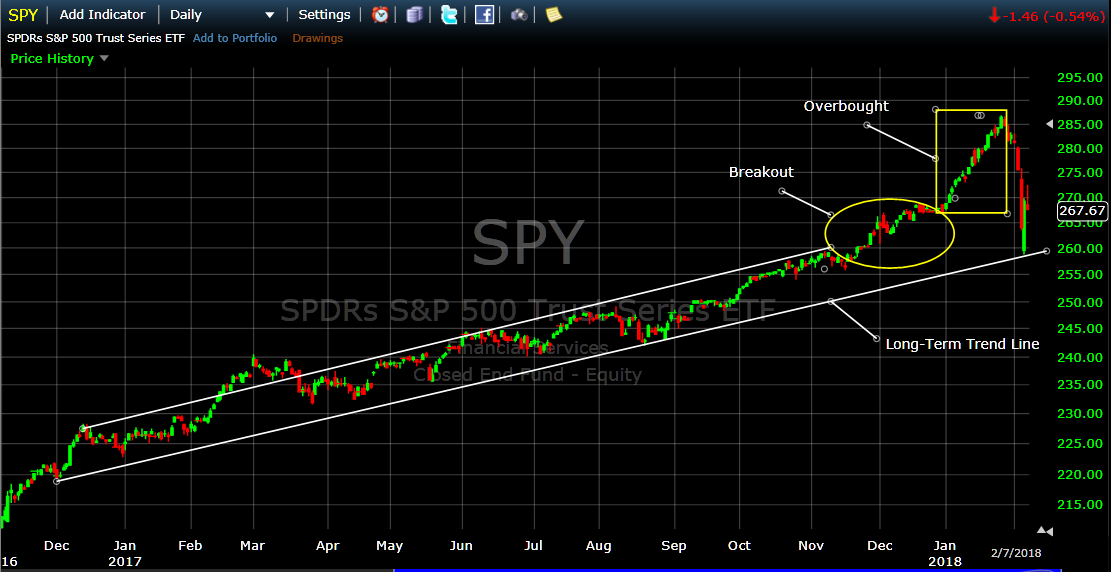
So, as we can see, the market could go either way at this time and MIPS members want to know if MIPS can react fast enough to protect us from losing big money (or even help us to make money in a down market).
This leads to the question, "Can MIPS respond quickly to a drop of 8-9%?"
The simple answer is that MIPS absolutely, positively CAN (and does) react to drops of -9% or less,
but it depends on the market circumstances at that time.
- MIPS can react to a 4-5% drop if the market has been relatively flat or growing very slowly, but
- MIPS will not react quickly to a 8-9% drop if the market has been growing fast and strong (as now)
- this decision is made by "relativity" algorithms that are built into the MIPS computer code
- and, these algorithms greatly reduce the probability of getting whipsawed.
To show this, look at the actual MIPS3 signals below in the stock market Crash of 2008
- this "Crash" started at the end of Oct 2007 and recovered in mid-March 2009.
In the graph below from TimerTrac.com, you can see that:
- MIPS issued a critical "short signal" in mid-Dec 2007
- and, this was after about a -5% drop
- during this time, the SPY dropped -60% and MIPS3 was up +140% (verified by TimerTrac.com).
PS - this performance resulted from trading the SPY Long/Short/Cash with no leverage.
Note: Red dots designate MIPS3 trade Signals
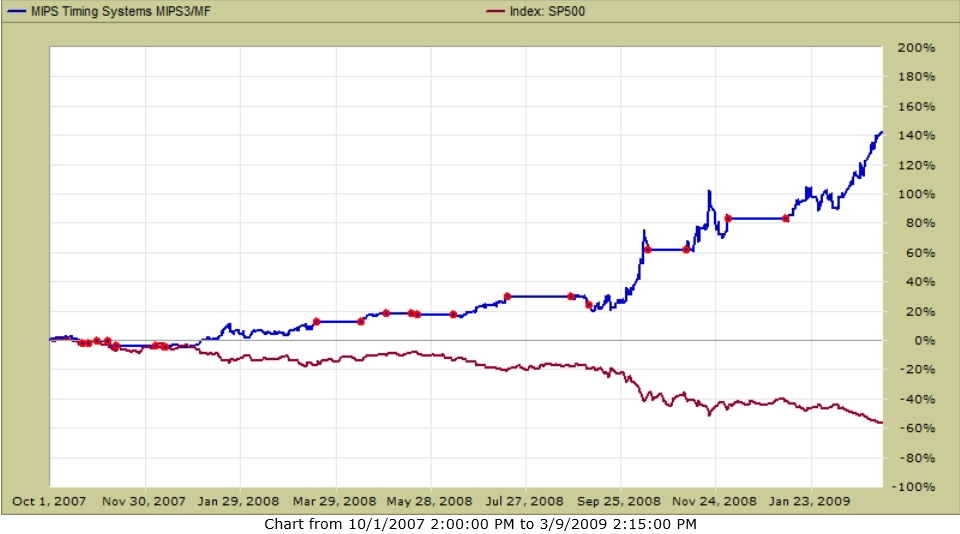
Hope this helps !!!
Paul Distefano
-- Contact Info ---
Paul Distefano, PhD
Founder/CEO
MIPS Timing Systems, LLC
Houston, TX
281-251-MIPS(6477)
www.mipstiming.com
support@mipstiming.com
Wednesday, February 07 2018
Wow! What a nerve-racking market we have had in the last few trading days. As of today's date, the S&P 500 is close to "giving back" all of the gains it made in 2018.
Seems like everyone wants to know "Is this a relatively small "dip" or a big "drop", as in an official correction? Or even, is this the beginning of a full fledge market crash.
I am very comfortable that MIPS would protect us form the "sting" of a crash (as in 2008, shown below), and I don't believe this is even in the cards at this time. The only "indicator" that I know that works 100% of the time is that market crashes DO NOT happen during strong economies with rising corporate profits. And, we have both at this time.
If I am correct above, this leaves us with either a smallish dip or a correction. If we are in for a smallish dip, this has already happened (-9%) and the market should head back up for a while (for about as long as our economy stays strong). But, we do not want the economy to get over-heated, because this will cause the Fed to stick their nose in and screw thing up by overreacting (like they almost always do).
I think we all know (or believe) that the two culprits that have caused the fast dip in market prices so far has been the very highly "overbought" market and the Fed's plans for interest rate hikes.
Let's look at the dip in the market a little closer and see how bad it actually has been before we discuss the reasons for the drop and how we are going to protect our portfolios now (see graph immediately below).
1) From Dec'16 to Nov'17 the SPY moved in a "near perfect" long-term trend.
2) In mid-Nov'17, the SPY picked up steam and moved above the upper line in the channel.
3) Between Jan 1, 2018 and Jan 26, 2018 the SPY took off like it was launched as a rocket.
4) Most investors knew this would come to an end, but not when.
5) Almost all pure reversion-to-the-mean models and algorithms were warning to get out, but
trend following models (like MIPS) usually would not trigger a cash or short signal as long
as the SPY remained above the long-term trendline (along with what the other indicators
and algorithms in the model were advising)
As you know (and can see below), the SPY dipped on Jan 29, 2018 and then dropped all he way
down to the long-term trendline on Feb 5th, and bounced back up some on Feb 6th. The SPY held
above the trendline again today (Feb 7th). Most likely, the SPY will again "test" the long-term
trendline; and, of course, it is of utmost importance for the SPY to remain above the trend-line.
Otherwise, look out for trouble.
Note: The graph below is using Monthly Bars.

So, as we can see, the market could go either way at this time and MIPS members want to know if MIPS can react fast enough to protect us from losing money (or even help us to make money in a down market)
This leads to the question "Can MIPS respond quickly to a drop of 8-9%?"
The simple answer is that MIPS absolutely, positively CAN (and does) react to drops of -9% or less,
but it depends on the market circumstances at that time.
- e.g., MIPS can react to a 4-5% drop if the market has been relatively flat or growing very slowly, but
- MIPS will not react too quickly to a 8-9% drop if the market has been growing fast and substantially
(as in the last several months)
- this decision is made by "relatively" algorithms that are built into the MIPS computer code
- and, these algorithms GREATLY reduce the probability of getting WHIPSAWED
To show this, look at the actual MIPS3 signals below in the stock market CRASH of 2008
- this CRASH started at the end of Oct 2007 and recovered in mid-March 2009
In the graph below from TimerTrac.com, you can see that:
- MIPS issued a critical "short signal" in mid-Dec 2007
- and, this was after about a -5% drop
- during this time, the SPY dropped -60% and MIPS3 was up +140% (verified by TimerTrac.com)
PS - this performance resulted from trading the SPY Long/Short/Cash with no leverage
Note: Red dots designate MIPS3 trade Signals

Hope this helps !!!
Paul Distefano
-- Contact Info ---
Paul Distefano, PhD
Founder/CEO
MIPS Timing Systems, LLC
Houston, TX
281-251-MIPS(6477)
www.mipstiming.com
support@mipstiming.com
Sunday, January 28 2018
Over the last 12 years, the MIPS models have traded an average of roughly 12-15 trades/year, depending on the model. But remember, an average of 12 trades/year over time can be 2-6 trades in some years and 15-20 trades/year in others.
When a timing model averages 12 trades/year, its Signal Life is about 30 days (one month). This is why MIPS is referred to as an Intermediate-Term trading model; whereas a model that makes 50 trades/year
with a signal life of about one week or 5 days, is a Short-Term trading model.
Good models only trade when the conditions that they are based upon change. For example, MIPS is basically a "Trend Following" model and will usually not change its Long or Short signals until the intermediate-term trend changes direction. I say "usually" because there are times when some the other indicators in MIPS (like, reversion-to-the-mean, overbought/sold, etc.) may override the trend signals.
The MIPS "Voting Tree"
MIPS is a VERY complicated, analytical model that uses over 150 indicators (some commercial, others proprietary) and a robust decision making process to ascertain if the market is climbing or diving. The math that we use includes artificial intelligence, pattern recognition, and self-developed applied mathematical algorithms (slopes, 2nd derivatives, rate-of-change, inflection points, etc.). The MIPS4 and Nitro models also use some "predictive algorithms" that anticipate changes in the markets a day or two before it happens. Gaining one day on both sides of each trade can make a significant difference in performance.
The main ingredient that we use to generate signals from our models comes mainly from the positions (Long/Short/Cash) of each and every one of our 150 Indicators. But, the process we developed does NOT simply add the positions of all of the 150 Indicators, and let the majority prevail. For example, if 77 of the Indicators are Long and 73 are short, using a Uni-Strategy voting process the consensus would be Long, but that is NOT where we stop.
The MIPS models actually use what we call a Multi-Strategy voting process, as depicted below. Please be aware that this is a simplified picture, and is less than 1/10th of the complexity used in the MIPS models. The raw 150 Indicators that we have been discussing start on the very bottom of each leg in the voting tree and they consolidate through a proprietary process that leads to a preliminary Signal decision at the very top. The indicators that are in the finals in the voting process, which we call the Super Indicators, are in the first line below the final Preliminary Signal. In the MIPS models, we use 15 Super Indicators.
These 15 Super Indicators form what we call our Core Model. We call the signals from the core models preliminary signals, and they are the base for each MIPS model. From here, algorithms that are specifically designed for each MIPS model convert the core model signals ("preliminary signals") into the final signals for each MIPS model. Going from preliminary signals to final signals for each MIPS model is a complicated, but it is a well defined process. And, it includes specific algorithms that basically define each MIPS model. Please understand that this algorithm is run on a daily basis. In less than 2-3 seconds, MIPS calculates what would take a human over 48 hours to calculate and analyze.
................................................................................. MIPS "Voting Tree"
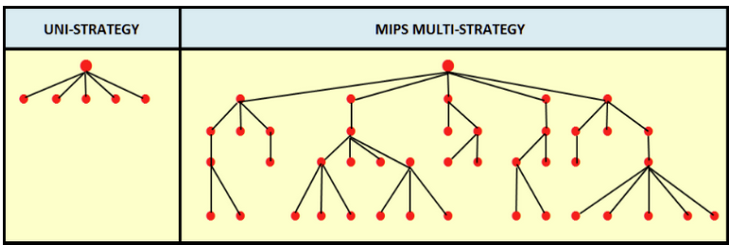
ACTUAL MIPS SIGNALS IN 2016-2017
At the bottom of this Blog, you will see a sample of the daily PRELIM signals for the MIPS Core Model since December 31, 2015 (column on the far right in the table); and a table containing a "sample" of what the MIPS Super Indicators that make it to Vote Line looked like in in early 2016 and in late 2017. From this, you will see the Core Model getting stronger-and-stronger Long as we reach today's date.
The information from the MIPS core model is a major part of the final signals for all of the MIPS models. The numbers in the table at the bottom of this Blog are the foundation for the signals from all MIPS models, but are not necessarily the final word for any. At any rate, the numbers basically show the strength of all of the Super Indicators daily.
From the table at the end of this Blog, you can see that:
a) the majority of the vote-line Super Indicators were Long for the last half of 2016 and the entire
year of 2017, and
b) the "reversion-to-the-mean" indicator is getting more negative with time.
Remember, we use over 150 sub-indicators, so each of the Super Indicators on the Vote Line are the consensus of an average of 10 sub-indicators beneath them. In actuality, the Super Indicators on the Vote Line daily are fed by 3-20 sub-indicators each. Note: This is the only time that we have exposed any part of the actual guts of the MIPS core model, so please do not share it.
NEVER BEFORE
With the above in mind, all of the MIPS models have remained LONG for over 12 months (some up to 18 months). I have been developing mathematical models to time the market for almost 20 years for myself and family, and MIPS3 itself went "public" in November 2005. And, I have NEVER experienced model behavior anywhere even close to what is happening now since the 1990's (and we know how that ended).
Even though the MIPS models have been Long for over one year, three of us here at MIPS Timing Systems still input data daily, run-the models each and every day, and compare our results before we send out signal emails to our MIPS Members. We take no "breaks", nor do we spend any less effort, regardless of whether or not a model issues a new signal on any day or keeps the existing one.
The daily positions (long/short/cash) from the MIPS models depend upon the position of each and every Indicator that we use, although not on a one-to-one basis. Each Indicator earns its own weighting in the voting system, based mainly by examining its own past performance (using artificial intelligence algorithms). That notwithstanding, the MIPS models are definitely "stronger" when the majority of the Super Indicators show the same position (long/short/cash).
WHAT WOULD YOU DO?
In conjunction with the above and given the facts below, what would you do?
(a) Corporate profits from large cap stocks have been growing at a rate not seen in the last 10 years,
(b) The SPY 500 has gone almost straight up daily over the last 12-15 months with very low volatility.
Would anyone expect a good investor or a good timing model to get out of the market (or go short)?
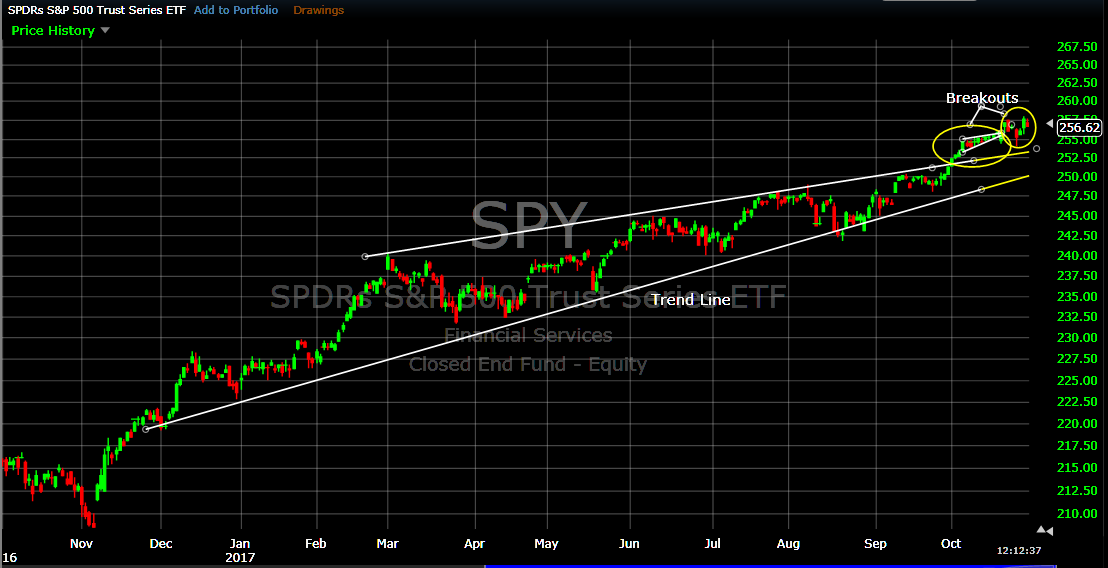
2016-17 MIPS/NITRO PERFORMANCE
....................(Long - Short Leverage)
MIPS/Nitro (1.50x - 0.5x leverage) +58%
MIPS/Nitro (1.25x- 0.5x leverage) +49%
MIPS/Nitro (1.00x -1.0x leverage) +39%
SPY................................................. +39%
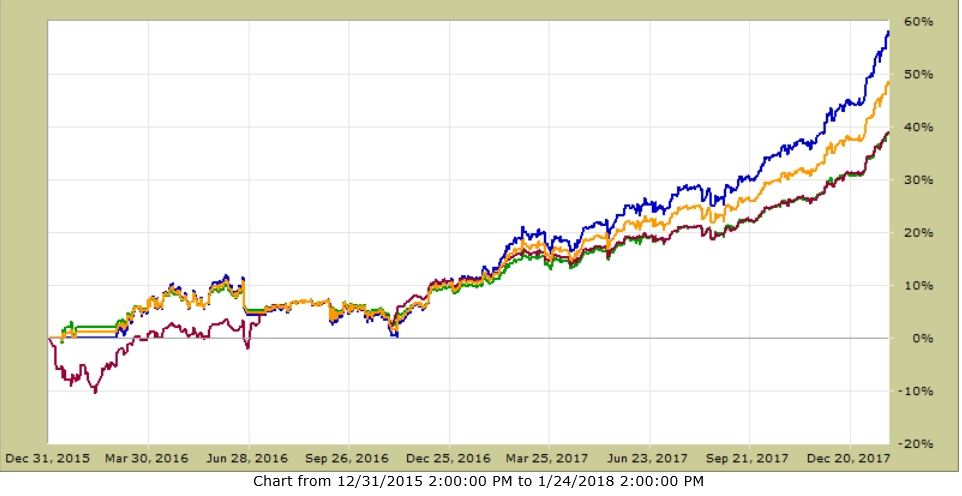
Some MIPS Members are worried because the MIPS models have been Long for over 18 months. Most of the time, worrying would be the right thing to do. Most models that do well in up markets, do poorly in down markets. And, a lot of the time, this means that these models have an up-bias and the developer is not even aware of it.
ANY GOOD MODEL MUST DO WELL IN UP AND DOWN MARKETS, and MIPS is one of them. We continually test our MIPS models with decaying market performance data to see how fast MIPS would pick up the drops; and how well (and fast) it performs at the turn-around point. On these, MIPS has an excellent batting average..
2008 MIPS3 PERFORMANCE
Thankfully, we do not have to guess how MIPS would have done in a market crash like 2008, because MIPS3 was LIVE in 2008 and was being tracked by TimerTrac.com. MIPS3's 2008 performance is shown below (hard to beat):
MIPS3 in 2008 (red dots designate trade dates)
MIPS +108% SPY -50%
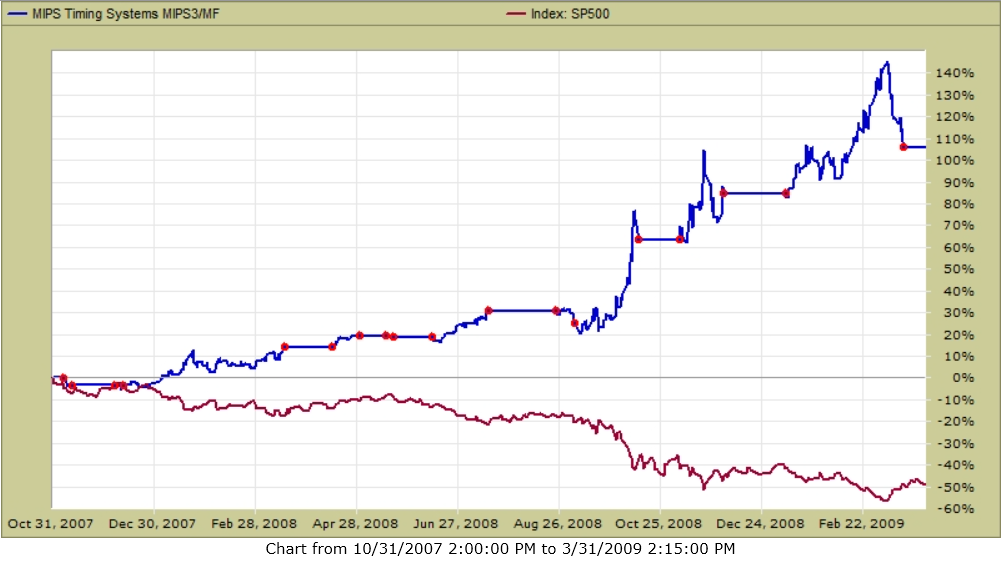
==============================================================================
The MIPS Models' Super Indicators and "Core Model" Signals
EARLY 2016
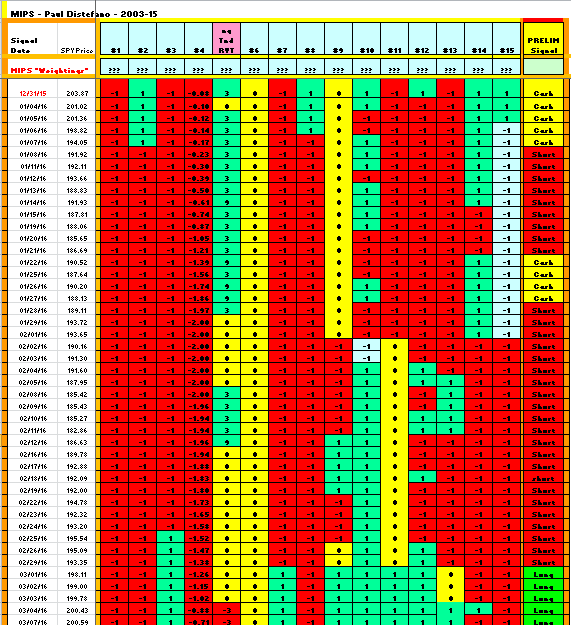
.
.
.
LATE 2017 (and now)
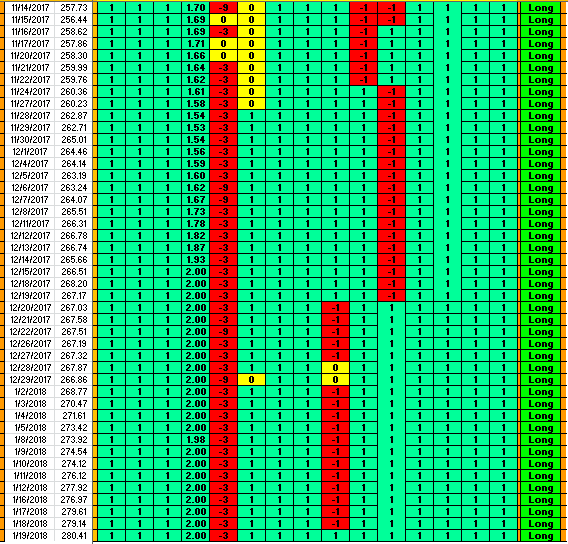
Good Trading...
Paul Distefano, PhD
MIPS Timing Systems, LLC
Houston, TX
281-251-MIPS(6477)
www.mipstiming.com
Sunday, January 07 2018
There is one (and maybe only one) economic fundamental condition that dictates, with almost 100% accuracy, if the market is going to move up or down in the intermediate-term future (months). That one fundamental condition is CORPORATE EARNINGS (of course, markets move up on increasing profits and it moves down on declining profits).
In fact, the market starts its move up or down before us little guys even have a clue as to which way profits are moving. The reason for this, of course, is because the largest institutional investors know in advance (at least 60-90 days) if their "clients" (the largest companies in America) are going to announce increasing or decreasing profits at the end of the current quarter. The fat kats also know the "outlook" for the future long before we do. They should know, because in most cases the fat kats are helping these large companies (their clients) to prepare these numbers for release at the end of the current quarter. Of course, the fat kats would not use that knowledge to their advantage over the little guys like us, right? Yeah, right!!!
We all know now that corporate profits are stronger than what they have been in the last 10 years. Most of us anticipated this with Trump's election, and traded accordingly. Since then, every quarter has been better than the previous quarter, and the outlook for 2018 is pointing in the same direction.
The MIPS models use hundreds of market indicators, mathematical equations, and artificial intelligence feedback to track the market and to decide the direction of the intermediate-term trend and the signal for each day. And, we follow the trend daily. Remember, "do not bet against the trend". In this market, as MIPS has correctly reported, the trend has been Long for over one year...
The MIPS models are still highly positive, but this does not mean that we could not have a smallish correction on the way to higher levels in the market (like from some of MIPS "reversion to the mean" algorithms). Stay tuned daily...
IMPORTANT... please read...
I am writing this for five reasons:
I.) to explain how and why a MIPS trading signal (which gets to our subscribers in a “Signal Change” email)
can last for a really long time (so-called “signal life”),
II.) to clarify how MIPS issues new signals and how we make our subscribers aware of the “Signal Status” for
each MIPS model EVERY DAY,
III) to show that more (unnecessary) trading usually yields worse results,
IV) to show the MIPS performance over the last 12 months, with and without leverage, and
V.) to show how MIPS3 performed in 2008
-------------------------------
I.) All good timing models have a foundation upon which they determine if investors should be in a Long, Short, or Cash position. Some of the underlying “foundations” of these models are trend following, reversion to the mean, momentum, relative strength, rate of change, etc. In general, the MIPS models are Trend Following models. But, believe it or not, they contain some of all of the above foundations (the MIPS models contain up to 165 standard technical indicators, artificial intelligence, pattern recognition, and applied math algorithms).
MIPS’ strength lies in its ability to determine when the market has “turned over” from up-to-down or from down-to-up (mathematically called “Inflection Points”).
We all know that the market basically moves in “cycles”; from short-term (days to weeks), to intermediate-term (weeks to months), and to long-term cycles (months to years). And, an intermediate-term cycle basically ignores short-term cycles and a long-term cycle ignores both short-term and intermediate-term cycles.
MIPS tracks intermediate-term cycles. “Cycles” in the stock market move from tops-to-bottoms, and then turn around and move from bottoms-to-tops. An up-trend is a series of higher highs and higher lows, and the up-trendline is a line along the bottoms (and the inverse for a down-trendline). See graph below.
A good trend following model will rarely change position unless the market breaks the trendline with force, and which has the support of a strong majority of the other technical algorithms confirming a market breach in the current direction.
With enough strength in a strong up-market, an intermediate-term cycle can turn into a long-term cycle. As can be seen in the graph below, in the last 12 months the market has moved up on what could be called a “near-perfect” up-trend, AND all of the MIPS models have remained LONG during this entire period (a new record of time for a MIPS “signal life”).
Remember, a good timing model not only needs to know when to trade, but it also needs to know when NOT to trade.

BTW:
The S&P 500 just set an all-time record for the number of consecutive days when the S&P 500 did not have a 3% loss. As of today’s date (10/30/2017) that would be very close to one year (247 trading days) !!! Of course, this usually means that it is very difficult for most timing models to “trade the dips”. It would be better to stay long with some leverage (like 1.5x leverage).
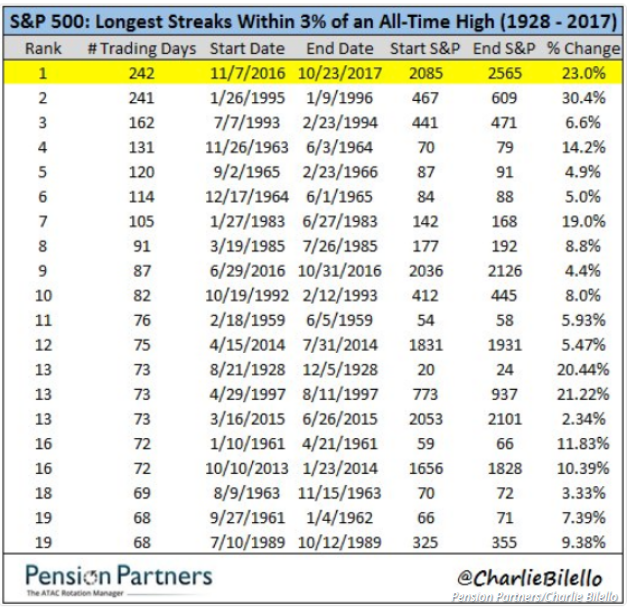
.
-------------------------------
II.) Moving on to Section II in this Blog, the MIPS models send out “Signal Change” emails every time that any one or more of the models instructs MIPS subscribers to “change” position (like from Long-to-Short, or from Short-to-Cash, etc). Of course, at MIPS we “run the models” EVERY DAY (in triplicate) to determine if any of the MIPS signals have changed. If so, we send out a "Signal Change" email after the close that day. If not, we send "Signal Status" emails to our subscribers every weekend. This way, if a subscriber missed a Signal Change email or forgot to trade it, they will be aware over the weekend that they missed a Signal Change.
A few market timers send out daily Signal Status emails. But we (along with most others), do not do so mainly because most of our subscribers and RIA customers do not want to be inundated with emails from MIPS unless there is a Signal Change (remember, there are about 240-250 trading days each year). Unfortunately, because we do not send out daily emails, some subscribers feel as if we are not paying attention to MIPS or the markets, which of course, is dead wrong.
-------------------------------
III) Regarding trading frequency, no one should change a winning position (execute another trade) unless the trend that the model is tracking has changed direction (in other works, “Don’t Fight The Trend”). And remember when you make a trade (like buy) you will ultimately need to reverse that trade (like sell or short). So, on each new trade, you must be correct on when to buy AND when to sell. A good example of this can be displayed by showing the performance of most of the timing models that were tracked by TimerTrac.com over the last 12 months (see Table below).
The table below from TimerTrac.com over the last 12 months shows (a) the performance (Gain/Loss %) with no leverage, and (b) the number of trades from over 75 of the models that it tracks. The MIPS models are at (or near the top), with only 2 trades from MIPS3 and no new trades from MIPS4 and Nitro.
Average:
Over the last 12 months
- the MIPS models averaged a gain/loss of 21.2%, with a average of 1 trade each.
- other models with over 80 trades averaged a gain/loss of -13.3%, with an average 117 trades each.
PS – Of course, this does NOT mean that models that trade less perform better…
Long-Term trading
Since Nov’05, the MIPS models have averaged 12-15 trades/year, with the lower ones being 2-4 trades/year and the high end being 16-20 trades/year. In the 18 months of the last market crash (Oct’07 – Mar’09) MIPS3 issued 18 trades.
|
|
|
|
|
|
|
|
|
|
|
|
|
|
|
|
|
|
|

|
|
|
|
|
Top Performers over the period from Monday, October 31, 2016 through Friday, October 27, 2017
|
|
The index SP500 gained 21.38% over this same time period.
|
|
|
|
|
|
|
|
|
|
Rank
|
Strategy Name
|
Gain/Loss %
|
Difference %
|
Trades
|
|
1
|
|
21.40%
|
0.01%
|
6
|
|
2
|
MIPS Timing Systems MIPS/Nitro
|
21.38%
|
0.00%
|
0
|
|
2
|
MIPS Timing Systems MIPS4.sso
|
21.38%
|
0.00%
|
0
|
|
2
|
|
21.38%
|
0.00%
|
0
|
|
2
|
|
21.38%
|
0.00%
|
0
|
|
2
|
|
21.38%
|
0.00%
|
0
|
|
2
|
|
21.38%
|
0.00%
|
0
|
|
2
|
|
21.38%
|
0.00%
|
0
|
|
2
|
|
21.38%
|
0.00%
|
0
|
|
2
|
|
21.38%
|
0.00%
|
0
|
|
2
|
|
21.38%
|
0.00%
|
0
|
|
2
|
|
21.38%
|
0.00%
|
0
|
|
2
|
|
21.38%
|
0.00%
|
0
|
|
2
|
|
21.38%
|
0.00%
|
0
|
|
2
|
|
21.38%
|
0.00%
|
0
|
|
3
|
|
21.38%
|
0.00%
|
6
|
|
4
|
MIPS Timing Systems MIPS3/MF
|
20.93%
|
-0.46%
|
2
|
|
5
|
|
20.79%
|
-0.59%
|
31
|
|
6
|
|
20.47%
|
-0.91%
|
2
|
|
7
|
|
18.99%
|
-2.39%
|
17
|
|
8
|
|
18.37%
|
-3.02%
|
94
|
|
9
|
|
18.05%
|
-3.33%
|
99
|
|
10
|
|
18.01%
|
-3.38%
|
7
|
|
11
|
|
17.77%
|
-3.61%
|
7
|
|
12
|
|
17.63%
|
-3.75%
|
6
|
|
13
|
|
17.53%
|
-3.85%
|
14
|
|
14
|
|
17.36%
|
-4.02%
|
8
|
|
15
|
|
17.08%
|
-4.30%
|
7
|
|
16
|
|
15.95%
|
-5.43%
|
3
|
|
17
|
|
15.43%
|
-5.95%
|
5
|
|
18
|
|
15.29%
|
-6.09%
|
15
|
|
19
|
|
14.76%
|
-6.62%
|
23
|
|
20
|
|
14.63%
|
-6.75%
|
3
|
|
21
|
|
14.37%
|
-7.01%
|
132
|
|
22
|
|
13.81%
|
-7.58%
|
132
|
|
22
|
|
13.81%
|
-7.58%
|
132
|
|
23
|
|
13.75%
|
-7.63%
|
24
|
|
24
|
|
13.08%
|
-8.30%
|
52
|
|
25
|
|
12.91%
|
-8.47%
|
49
|
|
26
|
|
12.71%
|
-8.67%
|
3
|
|
27
|
|
12.27%
|
-9.11%
|
42
|
|
28
|
|
12.16%
|
-9.22%
|
16
|
|
29
|
|
11.90%
|
-9.48%
|
12
|
|
30
|
|
11.64%
|
-9.74%
|
35
|
|
30
|
|
11.64%
|
-9.74%
|
35
|
|
30
|
|
11.64%
|
-9.74%
|
35
|
|
30
|
|
11.64%
|
-9.74%
|
35
|
|
30
|
|
11.64%
|
-9.74%
|
35
|
|
30
|
|
11.64%
|
-9.74%
|
35
|
|
31
|
|
11.41%
|
-9.97%
|
12
|
|
32
|
|
11.40%
|
-9.98%
|
16
|
|
33
|
|
11.32%
|
-10.07%
|
56
|
|
34
|
|
11.23%
|
-10.15%
|
50
|
|
35
|
|
11.16%
|
-10.22%
|
55
|
|
36
|
|
10.89%
|
-10.49%
|
10
|
|
37
|
|
10.71%
|
-10.67%
|
63
|
|
38
|
|
10.69%
|
-10.69%
|
81
|
|
39
|
|
10.66%
|
-10.72%
|
24
|
|
40
|
|
9.37%
|
-12.02%
|
17
|
|
41
|
|
8.83%
|
-12.55%
|
59
|
|
42
|
|
8.33%
|
-13.05%
|
90
|
|
43
|
|
8.00%
|
-13.38%
|
12
|
|
44
|
|
7.59%
|
-13.79%
|
4
|
|
45
|
|
7.32%
|
-14.07%
|
22
|
|
46
|
|
7.20%
|
-14.19%
|
10
|
|
47
|
|
7.10%
|
-14.28%
|
55
|
|
48
|
|
6.93%
|
-14.45%
|
7
|
|
49
|
|
6.88%
|
-14.50%
|
9
|
|
50
|
|
6.81%
|
-14.57%
|
21
|
|
51
|
|
6.60%
|
-14.78%
|
240
|
|
52
|
|
6.01%
|
-15.37%
|
43
|
|
53
|
|
5.75%
|
-15.63%
|
9
|
|
54
|
|
5.70%
|
-15.68%
|
152
|
|
55
|
|
5.69%
|
-15.69%
|
15
|
|
56
|
|
4.89%
|
-16.50%
|
49
|
|
57
|
|
4.88%
|
-16.50%
|
12
|
|
58
|
|
4.80%
|
-16.58%
|
10
|
|
59
|
|
4.64%
|
-16.74%
|
2
|
|
60
|
|
4.56%
|
-16.82%
|
12
|
|
61
|
|
4.31%
|
-17.07%
|
96
|
|
62
|
|
3.84%
|
-17.54%
|
234
|
|
63
|
|
3.59%
|
-17.79%
|
18
|
|
64
|
|
3.21%
|
-18.17%
|
14
|
|
65
|
|
3.17%
|
-18.22%
|
3
|
|
65
|
|
3.17%
|
-18.22%
|
3
|
|
65
|
|
3.17%
|
-18.22%
|
3
|
|
65
|
|
3.17%
|
-18.22%
|
3
|
|
66
|
|
2.35%
|
-19.03%
|
19
|
|
67
|
|
2.19%
|
-19.19%
|
23
|
|
68
|
|
0.00%
|
-21.38%
|
0
|
|
68
|
|
0.00%
|
-21.38%
|
0
|
|
68
|
|
0.00%
|
-21.38%
|
0
|
|
68
|
|
0.00%
|
-21.38%
|
0
|
|
68
|
|
0.00%
|
-21.38%
|
0
|
|
68
|
|
0.00%
|
-21.38%
|
0
|
|
68
|
|
0.00%
|
-21.38%
|
0
|
|
69
|
|
-0.53%
|
-21.91%
|
2
|
|
70
|
|
-0.81%
|
-22.20%
|
2
|
|
71
|
|
-0.85%
|
-22.24%
|
120
|
|
72
|
|
-1.65%
|
-23.04%
|
87
|
|
72
|
|
-1.65%
|
-23.04%
|
87
|
|
73
|
|
-2.78%
|
-24.16%
|
12
|
|
74
|
|
-3.60%
|
-24.98%
|
13
|
|
75
|
|
-5.60%
|
-26.98%
|
1
|
|
76
|
|
-15.28%
|
-36.66%
|
32
|
---------------------------------
IV) MIPS performance over the last 12 months (from TimerTrac.com)
- MIPS/Nitro with 2x leverage (blue line) + 50%
- MIPS4 with 1.5x leverage (gold line) + 36%
- MIPS3 with no leverage (green line) +21%
- SPY (red line) +21%
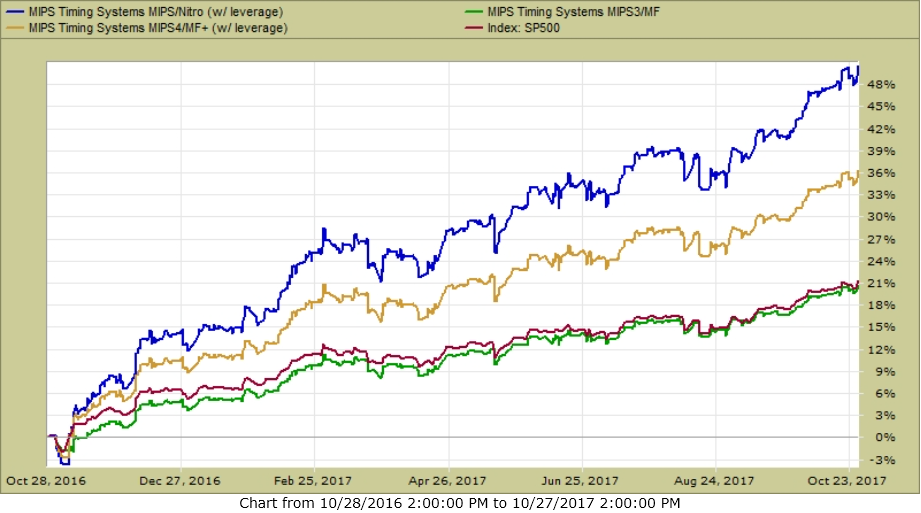
.
-----------------------------------
V.) How did MIPS perform in 2008
The graph below is:
(a) to prove that MIPS not only performs well in up markets, but also
(b) to show how fast MIPS3 actually responded to the market crash in 2008.
- MIPS3 issued its first short signal in 4Q’07 (verified by TimerTrac.com),
MIPS3 – 4Q’07 thru 1Q’09
- MIPS3 - blue line +106%
- SPY - red line -48%
Red dots indicate actual signals …
 . .
In summary, it seems that many “investors” get such a big “kick” out of trading, they lose track of the objective of making money. Many will not tolerate a lower frequency trading model, but seem to love higher frequency trading models that do not perform nearly as well as MIPS. You tell me why…
.
--------------------------------
Best Wishes…
Paul Distefano, PhD
CEO / Founder
MIPS Timing Systems, LLC
Houston, TX
281-251-MIPS(6477)
Saturday, November 18 2017
Some investors (including some MIPS members) seem to think that when there is not a position change (Signal Change) in a MIPS model for a long period of time, they are being ignored or something is wrong with the model that they are following. They can't seem to understand that a good model (like MIPS) only changes position when the market changes its behavior, and that change is detected by the model. With MIPS, this would be when the intermediate-term market "trend" changes direction. We at MIPS input data and run our models daily (in triplicate), independent of whether or not there is a change of any type.
All daily model developers (including MIPS) provide their subscribers with "Investment Positions" (Long or Short or Cash) about 250 days every year (52 weeks/year x 5 trading days/week - holidays). This is not a function of how often their models trade.
There is, however, a big difference in how these "Investment Positions" are reported amongst model developers (aka Signal Providers):
1) Some Signal Providers send out emails to subscribers with current positions every trading day, whether or not the signal has changed. Many subscribers do not like this because they get inundated with emails from their Signal Provider and many times they miss a "signal change" due to confusion or boredom.
2) Other Signal Providers only send out emails to subscribers when there is a change in position from their model. Subscribers don't like this because there can be long periods of time (weeks/months) when they don't hear from their Signal Provider, and hence they are not 100% sure that they did not miss a signal change somewhere along the way or that the Signal Provider is now inactive.
3) At MIPS (as with most other good Signal Providers), we send out
(a) A "Signal Change" email the very day that one of our models calls for a change in position
(Long-to-Short or Short-to-Cash or etc.)
(b) A "Signal Status" email every weekend showing the current position for all MIPS models.
Our subscribers like this because the "Signal Status" tells them if they are in the correct
position at that time.
The moral of this story is that MIPS runs its models each and every day, no matter what the market is doing. This includes the status and behavior of hundreds of technical indicators and mathematical equations, and thousands of calculations. it is NOT any easier to run the model when the current signal remains the same or when there is a signal change.
We report the results to you every time there is a Signal Change, with instructions on our website for you NOT to change this new position until there is another Signal Change issued by the MIPS model that you are trading with. In the meantime, we keep you up-to-date on the Signal Status for each MIPS model every weekend, in case you accidentally did not act on the latest Signal Change during the week.
Here are the trades (red dots) and performance of the MIPS3 model since 2016
Blue Line - MIPS3 1.5x Long / 0.5x Short +39%
Green Line - MIPS3 1.0x Long / 1.0x Short +27%
Red Line - SPY........................................... +27%
Red dots show actual trades
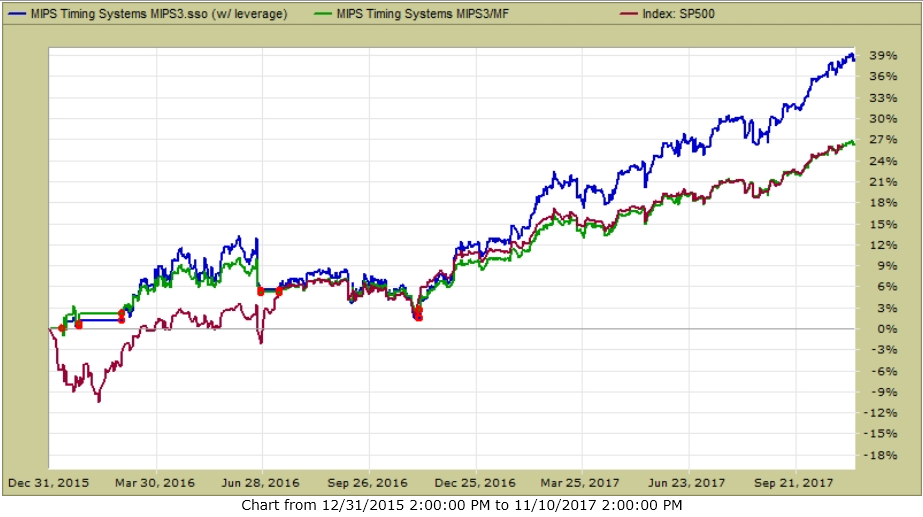
As you can see in the graph above, the last trade was in Nov 2016, and the trend has been very
consistent since then. In the graph below, you can see that the MIPS Strength Indicator shows little or no weakness (until last week).
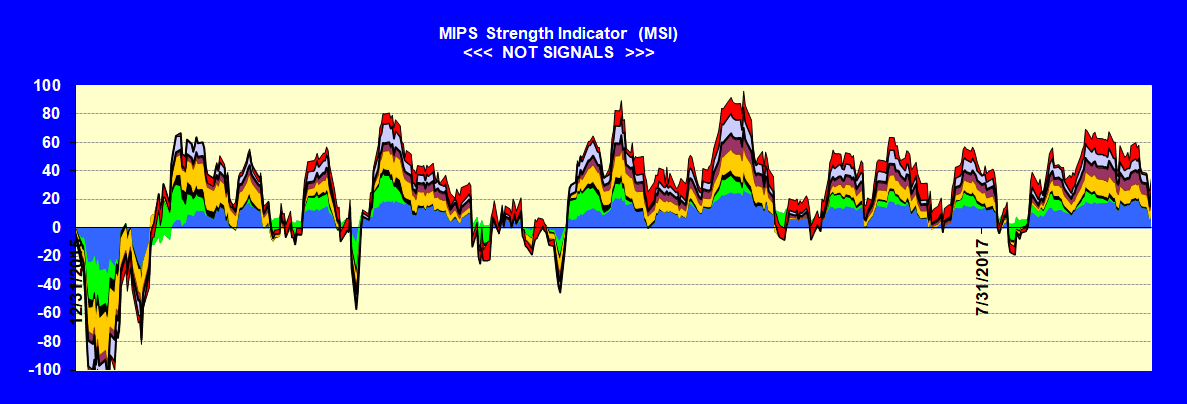
Best Wishes...
Paul Distefano, PhD
MIPS Timing Systems, LLC
Houston, TX
281-251-MIPS(6477)
Monday, October 30 2017
I am writing this for five reasons:
I.) to explain how and why a MIPS trading signal (which gets to our subscribers in a “Signal Change” email)
can last for a really long time (so-called “signal life”),
II.) to clarify how MIPS issues new signals and how we make our subscribers aware of the “Signal Status” for
each MIPS model EVERY DAY,
III) to show that more (unnecessary) trading usually yields worse results,
IV) to show the MIPS performance over the last 12 months, with and without leverage, and
V.) to show how MIPS3 performed in 2008
-------------------------------
I.) All good timing models have a foundation upon which they determine if investors should be in a Long, Short, or Cash position. Some of the underlying “foundations” of these models are trend following, reversion to the mean, momentum, relative strength, rate of change, etc. In general, the MIPS models are Trend Following models. But, believe it or not, they contain some of all of the above foundations (the MIPS models contain up to 165 standard technical indicators, artificial intelligence, pattern recognition, and applied math algorithms).
MIPS’ strength lies in its ability to determine when the market has “turned over” from up-to-down or from down-to-up (mathematically called “Inflection Points”).
We all know that the market basically moves in “cycles”; from short-term (days to weeks), to intermediate-term (weeks to months), and to long-term cycles (months to years). And, an intermediate-term cycle basically ignores short-term cycles and a long-term cycle ignores both short-term and intermediate-term cycles.
MIPS tracks intermediate-term cycles. “Cycles” in the stock market move from tops-to-bottoms, and then turn around and move from bottoms-to-tops. An up-trend is a series of higher highs and higher lows, and the up-trendline is a line along the bottoms (and the inverse for a down-trendline). See graph below.
A good trend following model will rarely change position unless the market breaks the trendline with force, and which has the support of a strong majority of the other technical algorithms confirming a market breach in the current direction.
With enough strength in a strong up-market, an intermediate-term cycle can turn into a long-term cycle. As can be seen in the graph below, in the last 12 months the market has moved up on what could be called a “near-perfect” up-trend, AND all of the MIPS models have remained LONG during this entire period (a new record of time for a MIPS “signal life”).
Remember, a good timing model not only needs to know when to trade, but it also needs to know when NOT to trade.

BTW:
The S&P 500 just set an all-time record for the number of consecutive days when the S&P 500 did not have a 3% loss. As of today’s date (10/30/2017) that would be very close to one year (247 trading days) !!! Of course, this usually means that it is very difficult for most timing models to “trade the dips”. It would be better to stay long with some leverage (like 1.5x leverage).

.
-------------------------------
II.) Moving on to Section II in this Blog, the MIPS models send out “Signal Change” emails every time that any one or more of the models instructs MIPS subscribers to “change” position (like from Long-to-Short, or from Short-to-Cash, etc). Of course, at MIPS we “run the models” EVERY DAY (in triplicate) to determine if any of the MIPS signals have changed. If so, we send out a "Signal Change" email after the close that day. If not, we send "Signal Status" emails to our subscribers every weekend. This way, if a subscriber missed a Signal Change email or forgot to trade it, they will be aware over the weekend that they missed a Signal Change.
A few market timers send out daily Signal Status emails. But we (along with most others), do not do so mainly because most of our subscribers and RIA customers do not want to be inundated with emails from MIPS unless there is a Signal Change (remember, there are about 240-250 trading days each year). Unfortunately, because we do not send out daily emails, some subscribers feel as if we are not paying attention to MIPS or the markets, which of course, is dead wrong.
-------------------------------
III) Regarding trading frequency, no one should change a winning position (execute another trade) unless the trend that the model is tracking has changed direction (in other works, “Don’t Fight The Trend”). And remember when you make a trade (like buy) you will ultimately need to reverse that trade (like sell or short). So, on each new trade, you must be correct on when to buy AND when to sell. A good example of this can be displayed by showing the performance of most of the timing models that were tracked by TimerTrac.com over the last 12 months (see Table below).
The table below from TimerTrac.com over the last 12 months shows (a) the performance (Gain/Loss %) with no leverage, and (b) the number of trades from over 75 of the models that it tracks. The MIPS models are at (or near the top), with only 2 trades from MIPS3 and no new trades from MIPS4 and Nitro.
Average:
Over the last 12 months
- the MIPS models averaged a gain/loss of 21.2%, with a average of 1 trade each.
- other models with over 80 trades averaged a gain/loss of -13.3%, with an average 117 trades each.
PS – Of course, this does NOT mean that models that trade less perform better…
Long-Term trading
Since Nov’05, the MIPS models have averaged 12-15 trades/year, with the lower ones being 2-4 trades/year and the high end being 16-20 trades/year. In the 18 months of the last market crash (Oct’07 – Mar’09) MIPS3 issued 18 trades.
|
|
|
|
|
|
|
|
|
|
|
|
|
|
|
|
|
|
|

|
|
|
|
|
Top Performers over the period from Monday, October 31, 2016 through Friday, October 27, 2017
|
|
The index SP500 gained 21.38% over this same time period.
|
|
|
|
|
|
|
|
|
|
Rank
|
Strategy Name
|
Gain/Loss %
|
Difference %
|
Trades
|
|
1
|
|
21.40%
|
0.01%
|
6
|
|
2
|
MIPS Timing Systems MIPS/Nitro
|
21.38%
|
0.00%
|
0
|
|
2
|
MIPS Timing Systems MIPS4.sso
|
21.38%
|
0.00%
|
0
|
|
2
|
|
21.38%
|
0.00%
|
0
|
|
2
|
|
21.38%
|
0.00%
|
0
|
|
2
|
|
21.38%
|
0.00%
|
0
|
|
2
|
|
21.38%
|
0.00%
|
0
|
|
2
|
|
21.38%
|
0.00%
|
0
|
|
2
|
|
21.38%
|
0.00%
|
0
|
|
2
|
|
21.38%
|
0.00%
|
0
|
|
2
|
|
21.38%
|
0.00%
|
0
|
|
2
|
|
21.38%
|
0.00%
|
0
|
|
2
|
|
21.38%
|
0.00%
|
0
|
|
2
|
|
21.38%
|
0.00%
|
0
|
|
2
|
|
21.38%
|
0.00%
|
0
|
|
3
|
|
21.38%
|
0.00%
|
6
|
|
4
|
MIPS Timing Systems MIPS3/MF
|
20.93%
|
-0.46%
|
2
|
|
5
|
|
20.79%
|
-0.59%
|
31
|
|
6
|
|
20.47%
|
-0.91%
|
2
|
|
7
|
|
18.99%
|
-2.39%
|
17
|
|
8
|
|
18.37%
|
-3.02%
|
94
|
|
9
|
|
18.05%
|
-3.33%
|
99
|
|
10
|
|
18.01%
|
-3.38%
|
7
|
|
11
|
|
17.77%
|
-3.61%
|
7
|
|
12
|
|
17.63%
|
-3.75%
|
6
|
|
13
|
|
17.53%
|
-3.85%
|
14
|
|
14
|
|
17.36%
|
-4.02%
|
8
|
|
15
|
|
17.08%
|
-4.30%
|
7
|
|
16
|
|
15.95%
|
-5.43%
|
3
|
|
17
|
|
15.43%
|
-5.95%
|
5
|
|
18
|
|
15.29%
|
-6.09%
|
15
|
|
19
|
|
14.76%
|
-6.62%
|
23
|
|
20
|
|
14.63%
|
-6.75%
|
3
|
|
21
|
|
14.37%
|
-7.01%
|
132
|
|
22
|
|
13.81%
|
-7.58%
|
132
|
|
22
|
|
13.81%
|
-7.58%
|
132
|
|
23
|
|
13.75%
|
-7.63%
|
24
|
|
24
|
|
13.08%
|
-8.30%
|
52
|
|
25
|
|
12.91%
|
-8.47%
|
49
|
|
26
|
|
12.71%
|
-8.67%
|
3
|
|
27
|
|
12.27%
|
-9.11%
|
42
|
|
28
|
|
12.16%
|
-9.22%
|
16
|
|
29
|
|
11.90%
|
-9.48%
|
12
|
|
30
|
|
11.64%
|
-9.74%
|
35
|
|
30
|
|
11.64%
|
-9.74%
|
35
|
|
30
|
|
11.64%
|
-9.74%
|
35
|
|
30
|
|
11.64%
|
-9.74%
|
35
|
|
30
|
|
11.64%
|
-9.74%
|
35
|
|
30
|
|
11.64%
|
-9.74%
|
35
|
|
31
|
|
11.41%
|
-9.97%
|
12
|
|
32
|
|
11.40%
|
-9.98%
|
16
|
|
33
|
|
11.32%
|
-10.07%
|
56
|
|
34
|
|
11.23%
|
-10.15%
|
50
|
|
35
|
|
11.16%
|
-10.22%
|
55
|
|
36
|
|
10.89%
|
-10.49%
|
10
|
|
37
|
|
10.71%
|
-10.67%
|
63
|
|
38
|
|
10.69%
|
-10.69%
|
81
|
|
39
|
|
10.66%
|
-10.72%
|
24
|
|
40
|
|
9.37%
|
-12.02%
|
17
|
|
41
|
|
8.83%
|
-12.55%
|
59
|
|
42
|
|
8.33%
|
-13.05%
|
90
|
|
43
|
|
8.00%
|
-13.38%
|
12
|
|
44
|
|
7.59%
|
-13.79%
|
4
|
|
45
|
|
7.32%
|
-14.07%
|
22
|
|
46
|
|
7.20%
|
-14.19%
|
10
|
|
47
|
|
7.10%
|
-14.28%
|
55
|
|
48
|
|
6.93%
|
-14.45%
|
7
|
|
49
|
|
6.88%
|
-14.50%
|
9
|
|
50
|
|
6.81%
|
-14.57%
|
21
|
|
51
|
|
6.60%
|
-14.78%
|
240
|
|
52
|
|
6.01%
|
-15.37%
|
43
|
|
53
|
|
5.75%
|
-15.63%
|
9
|
|
54
|
|
5.70%
|
-15.68%
|
152
|
|
55
|
|
5.69%
|
-15.69%
|
15
|
|
56
|
|
4.89%
|
-16.50%
|
49
|
|
57
|
|
4.88%
|
-16.50%
|
12
|
|
58
|
|
4.80%
|
-16.58%
|
10
|
|
59
|
|
4.64%
|
-16.74%
|
2
|
|
60
|
|
4.56%
|
-16.82%
|
12
|
|
61
|
|
4.31%
|
-17.07%
|
96
|
|
62
|
|
3.84%
|
-17.54%
|
234
|
|
63
|
|
3.59%
|
-17.79%
|
18
|
|
64
|
|
3.21%
|
-18.17%
|
14
|
|
65
|
|
3.17%
|
-18.22%
|
3
|
|
65
|
|
3.17%
|
-18.22%
|
3
|
|
65
|
|
3.17%
|
-18.22%
|
3
|
|
65
|
|
3.17%
|
-18.22%
|
3
|
|
66
|
|
2.35%
|
-19.03%
|
19
|
|
67
|
|
2.19%
|
-19.19%
|
23
|
|
68
|
|
0.00%
|
-21.38%
|
0
|
|
68
|
|
0.00%
|
-21.38%
|
0
|
|
68
|
|
0.00%
|
-21.38%
|
0
|
|
68
|
|
0.00%
|
-21.38%
|
0
|
|
68
|
|
0.00%
|
-21.38%
|
0
|
|
68
|
|
0.00%
|
-21.38%
|
0
|
|
68
|
|
0.00%
|
-21.38%
|
0
|
|
69
|
|
-0.53%
|
-21.91%
|
2
|
|
70
|
|
-0.81%
|
-22.20%
|
2
|
|
71
|
|
-0.85%
|
-22.24%
|
120
|
|
72
|
|
-1.65%
|
-23.04%
|
87
|
|
72
|
|
-1.65%
|
-23.04%
|
87
|
|
73
|
|
-2.78%
|
-24.16%
|
12
|
|
74
|
|
-3.60%
|
-24.98%
|
13
|
|
75
|
|
-5.60%
|
-26.98%
|
1
|
|
76
|
|
-15.28%
|
-36.66%
|
32
|
---------------------------------
IV) MIPS performance over the last 12 months (from TimerTrac.com)
- MIPS/Nitro with 2x leverage (blue line) + 50%
- MIPS4 with 1.5x leverage (gold line) + 36%
- MIPS3 with no leverage (green line) +21%
- SPY (red line) +21%

.
-----------------------------------
V.) How did MIPS perform in 2008
The graph below is:
(a) to prove that MIPS not only performs well in up markets, but also
(b) to show how fast MIPS3 actually responded to the market crash in 2008.
- MIPS3 issued its first short signal in 4Q’07 (verified by TimerTrac.com),
MIPS3 – 4Q’07 thru 1Q’09
- MIPS3 - blue line +106%
- SPY - red line -48%
Red dots indicate actual signals …
 . .
In summary, it seems that many “investors” get such a big “kick” out of trading, they lose track of the objective of making money. Many will not tolerate a lower frequency trading model, but seem to love higher frequency trading models that do not perform nearly as well as MIPS. You tell me why…
.
--------------------------------
Best Wishes…
Paul Distefano, PhD
CEO / Founder
MIPS Timing Systems, LLC
Houston, TX
281-251-MIPS(6477)
Support@mipstiming.com
www.mipstiming.com
Sunday, October 22 2017
Recently it seems that the major concern from almost all investors in the stock market is: “How much longer will this market continue to run up?” That is a very legitimate question, and it has a very simple answer (which, of course, is unusual in stock market behavior). More later …
BUT FIRST …
The recent Bull Run (since election in Nov’16) in this very strong Bull Market (since 2009) has been very consistent, and with very low volatility.
Some of the characteristics of this strong Bull Run are:
- Using data all the way back to 1928, this Bull Run has just tied an 11-month “streak” from the 1990’s where the market did not experience a “correction” worse than -3%.
- This is the first time in 20 years that the DOW was up for 8 quarters in a row.
- The Dow and SP500 experienced 9 monthly gains in a row, with both reaching multiple new highs in September.
Going forward, some interesting historical statistics from Market Watch (4th Quarter Reputation) are:
1) Historically the 4th quarter is the strongest quarter of the year.
2) Since 1950, the 4th quarter has been up 80% of the time, with an average growth
of nearly 4%.
3) September is usually the worst month the year, but not this year.
4) In 11 of the last 12 years, when the S&P 500 was up more than 10% through the
3rd quarter and it made a new high in September, the average 4th quarter returns
have been +5.9%.
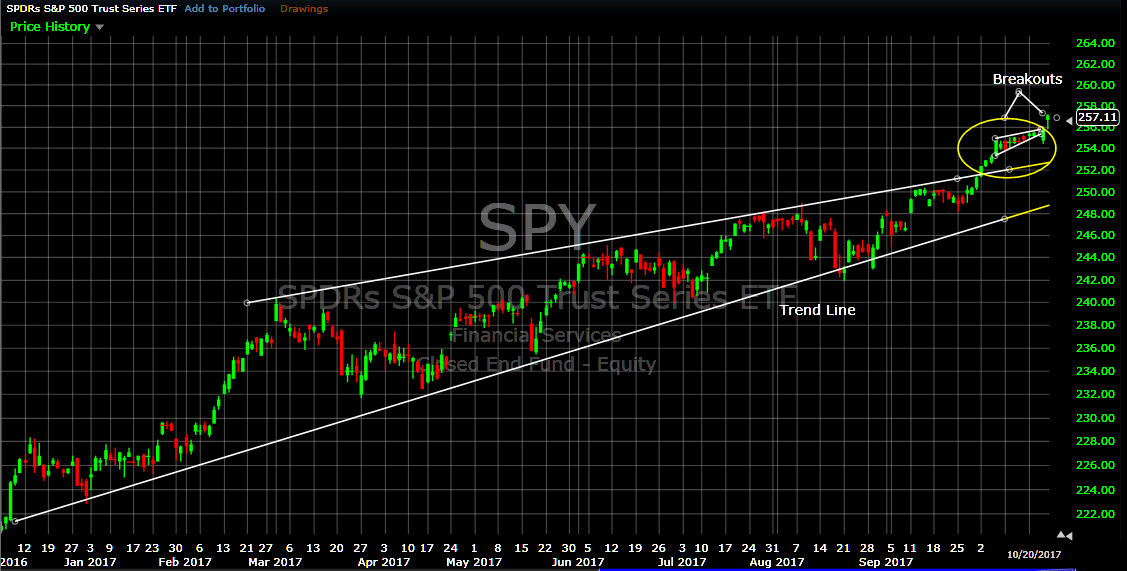
WHAT IS DRIVING THIS MARKET?
Like almost all other times in the market, the ultimate driver of stock prices is CORPORATE EARNINGS. The market is certainly somewhat influenced by other things (like, inflation, interest rates, global instability, etc.), but these are not consistent predictors of future market direction. For example, over the last 20+ years, the market has moved both with and against inflation. So, when following anything other than earnings, usually the effect is temporary (like BREXIT) or way off in time.
From Morgan Stanley
Blue Line (Left Scale) = Earnings
Gold Line (Right Scale) = Stock Gains/Losses
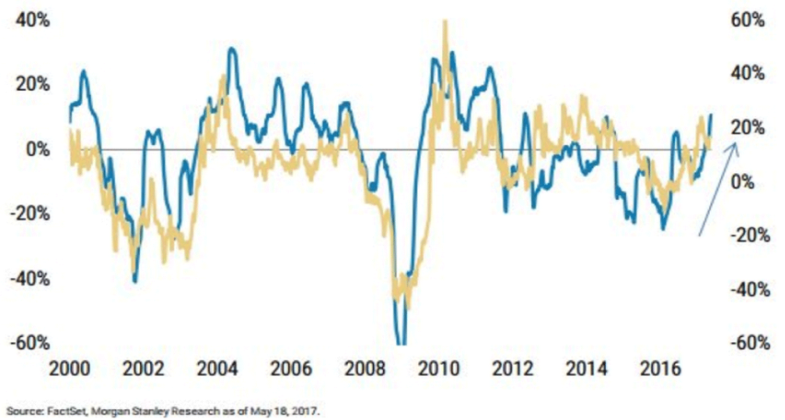
As can be seen above, stock prices ultimately follow corporate earnings. But in many cases, stock prices move first, in anticipation of earnings growth. The recent behavior in the market is a good example of this. Investors began pushing stock prices up immediately after the presidential election in anticipation of Trump’s economic agenda (fewer regulations, lower corporate taxes, better international tariffs, etc.) leading to more jobs and higher earnings. Since then, economic conditions have improved nicely and stock prices continue to rise.
So, why are so many investors so skeptical? Mainly because they feel that the stock market is greatly “oversold”, because stock prices are way too high as measured by the Price/Earnings (P/E) ratios of the major Indices. For example, the P/E ratio for the S&P 500 Index is now over 25, when the long-term average is closer to 15. That is indeed high and could lead to bad future returns; but it does not necessarily have to.
Many investors mistakenly interpret the above as a condition when prices must drop in order to bring the P/E ratio back down closer to past averages. BUT, what most of them seem to miss (or discount) is that the P/E ratio of an Index (like the S&P 500) also comes down when Earnings rise, even if stock Prices remain about the same. [Remember, the value of a “ratio” like A/B comes down when the denominator “B” goes up if the numerator “A” stays the same.] And, the “E” (earnings) in the PE ratio is now on the rise at a high pace and this should continue, given lower corporate taxes and more attractive international tariffs for US companies.
WARNING:
Please be aware that, if the economic progress in our country gets derailed (failed tax cuts, lower job creation, lower corporate earnings, North Korea, etc), the current Bull Run could (and most likely would) quickly “stop running” and it may even turn into a classic market crash.
So, how have the MIPS models performed in the last 12 months?
RECENT Performance of the MIPS3 model:
- 12 months ending 10/20/2017
- with and without leverage *
MIPS3 (last 12 months)
- Trading SPY Long / SH Short
Green Line 1.5 x Long / 0.5x Short +31%*
Blue Line 1.0x Long / 1.0x Short +20%
Red Line - SPY Buy/Hold +21%
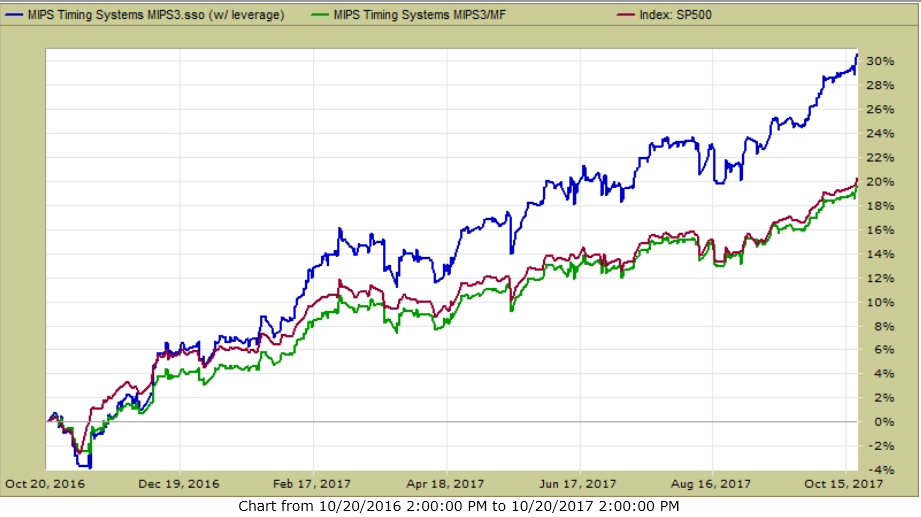
Best Wishes…
Paul Distefano, PhD
MIPS Timing Systems, LLC
Houston, TX
281-251-MIPS(6477)
Monday, October 02 2017
Can anyone develop a "perfect timing model"? Not at this time, but with advances in quantitative modeling (applied mathematics, artificial intelligence, pattern recognition, big data, etc.), the accuracy of quantitative modeling is improving amazingly fast. In 10-15 years, computer trading will be dominant.
In fact, outside of the investment community, the rest of the world has had "near perfect" models in use for many years now. Some examples are: (a) auto-pilot in commercial aircraft, (b) auto-control of nuclear power plants, (c) rockets that send men to the moon and back safely, and (d) fighter jet software (F-15 and F-35) that seeks, finds, tracks, and shoots down enemy aircraft amazingly fast.
Immediately below, let's look at an illustration of a "Perfect Timing Model" beating buy-and-hold in the stock market. After that, we can see how a real timing model actually worked in 2007-2017, as verified by TimerTrac.com. Then, you can determine for yourself if a model like this is "near-perfect enough" for you, or if you think that you can do better yourself.
PERFECT TIMING MODEL
Every investor (large and small) wants to make money in both up and down markets, but they don't know how. Indeed, this is difficult but not impossible. The illustration below shows the hypothetical performance with both a Buy-and-Hold Strategy and a Perfect Timing Model (Buy/Short). Even though a perfect Timing Model does not exist, some models on the market today (like MIPS) come close as they soundly beat Buy/Hold over time.
Let's suppose the market performs as in the table immediately below for 4 "Legs" of ups and downs:
I.) The middle column in the table and the graph below on the left show the performance of Buy/Hold.
II.) The rightmost column in the table and the graph on the right represent the performance of a
Perfect Timing Model.

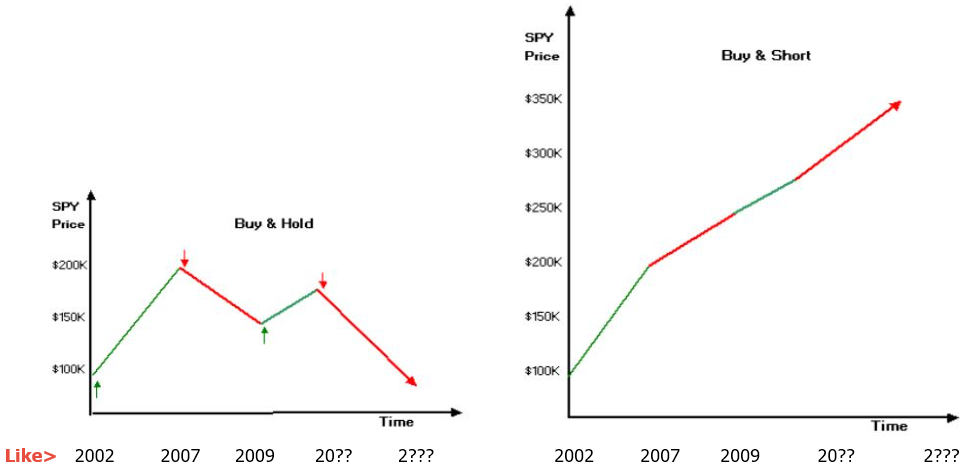
A REAL TIMING MODEL (near perfect?)
The section shows the actual MIPS3/MF.org performance in a market moving something like that of the first 3 "Legs" depicted above, by using actual data from the period of 2007-2017 ytd (verified by TimerTrac.com). Why just 3 Legs? Because, since 2009. the market is still on the 3rd Leg. The next big drop will be like the 4th Leg above, and it is definitely coming.
If you asked hundreds of investors questions about investing in the stock market, you would get diverse answers to each question. There is one question, however, that they would all answer with a resounding "YES". That question is: "Would you have a lot more money today had you not lost 35-60% of your portfolio value in the market crashes in 2000 and 2008?"
That is why the primary objective for a stock market timing model should be to beat the major indices (like the S&P 500 ETF "SPY") in UP and DOWN markets. But, in real life, it would be more realistic to say that the objective should be to keep up with or beat the SPY in up markets, and either go to cash or soundly beat the SPY in down markets. It's sad to say that only a very few timing models meet that objective on a long-term basis. Most do well in up markets but not so well in down markets, or vice versa.
To this end, below you will find results from TimerTrac.com for our MIPS3/MF.org model between 2007 and 2017 ytd. For this, we traded with a popular investing strategy, namely 1.5x SPY Long and 0.5x SH Short (0.5x SH Short for lower risk).
|
Time Frame
|
SPY Buy/Hold
|
MIPS3.org
1.5x / 0.5x
|
| 2006 - 2007 |
+15.5% |
+20.5% |
| 2008 |
-38.5% |
+22.0% |
| 2009 - 2017 |
+170.0% |
+370.0% |
GRAPHS
The vertical "scales" on the graphs below are different from each other
(scales optimised to show the complete graph in the same space)
I.) MIPS3/MF.org
Trading 1.5x SPY / 0.5x SH
2006-2007 <==
Up Market
MIPS 1.5x Long /0.5x Short +20.5%
SPY Buy-and-Hold +15.5%
* Red dots designate trade dates
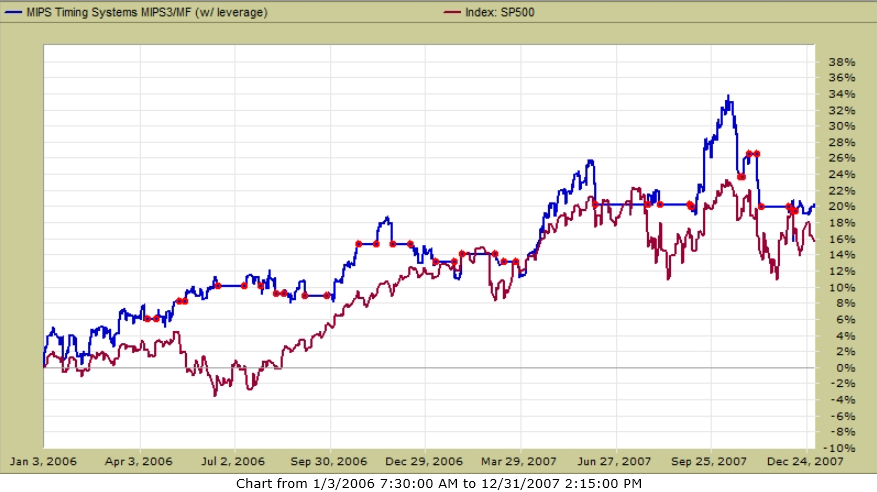
II.) MIPS3/MF.org
Trading 1.5x SPY / 0.5x SH
2008 <==
Down Market
MIPS 1.5x Long /0.5x Short +22.0%
SPY Buy-and-Hold - 38.5%
* Red dots designate trade dates
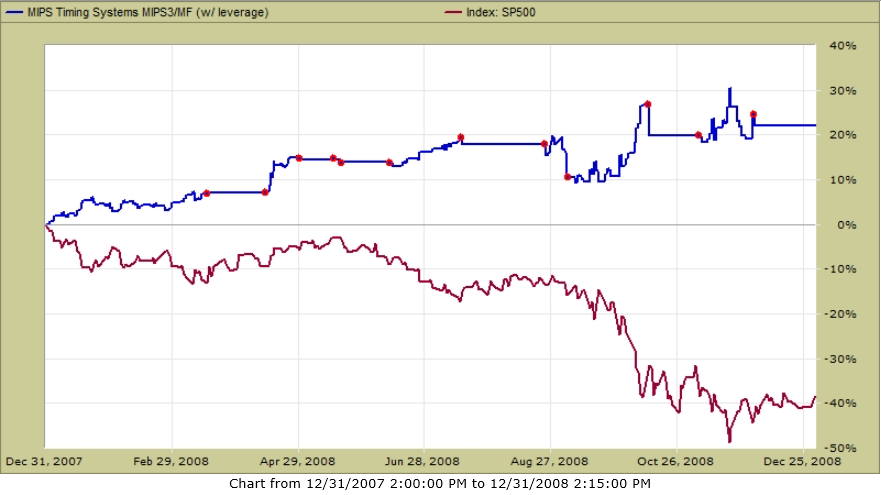
III.) MIPS3/MF.org
Trading 1.5x SPY / 0.5x SH
2009-2017 ytd <==
Up Market
MIPS 1.5x Long /0.5x Short +370%
SPY Buy-and-Hold +170%
* Red dots designate trade dates
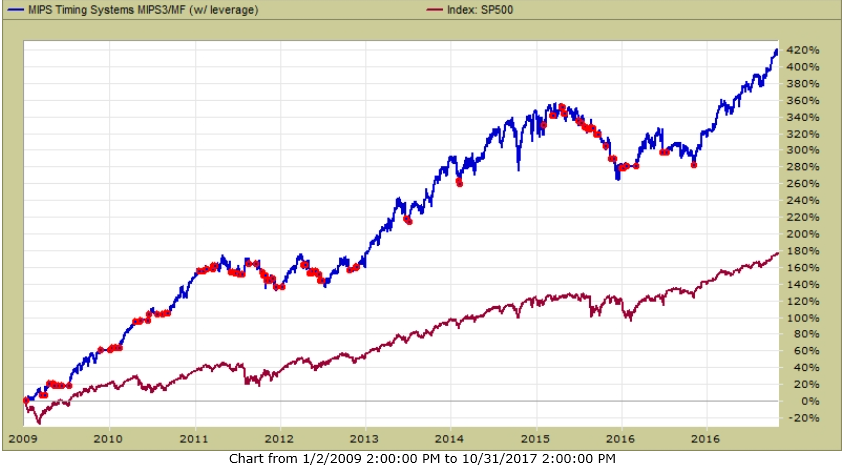
Monday, September 25 2017
Evaluating Timing Models !!!
Stock market timing models are difficult to evaluate, but you do not have to completely understand the interworking of the models.
For any model you are considering investing with, you should at least know:
- What is the background of the model developer ?
- that is, is he/she qualified to develop a sophisticated timing model ?
- On average, how many times does the model trade every year ?
- some models issue about 12 trades/year and others over 100 times/year.
- Are the long-term performance results of the model outstanding ?
- for example, does the model beat buy-and-hold in both up and down markets ?
- to satisfy the above, your evaluation must include at least one market crash (as in 2008).
- Are the performance results Verified by a 3rd-party tracking company ? ***
- like, TimerTrac.com, ThetaResearch.com, etc.
*** Non-Verified Performance
If the hypothetical backtested (non-verified) performance of a model:
- comes from a company's first model, do not trust the results;
- comes from a company that has several older verified models that produced lousy performance results, do not trust the newer results;
- comes from a company that has several older verified models that produced very good performance, you can trust the results from the new models (because they usually retain 85-90% of the code/signals from the older models, together with 10-15% of new code that contains algorithms which produce a higher percentage of winning trades).
If the information that you have available for any model is not enough
to satisfy the conditions above, you should NOT use that model.
On the other hand, it you can evaluate a model as above,
you most likely do not need any other info !!!
Friday, September 22 2017
ABSOLUTELY NOT !!!
The table below shows the ranking of the top 25 models that TimerTrac.com tracked in the period of
2007 - 2017 ytd. MIPS3/MF is the #1 Ranked model out of the top 25.
Please note that the performance of these models is NOT correlated to the number of trades they issued.
For Example:
MIPS traded about 130 times in this 10-year period and was the #1 Ranked model with a gain of 362%, whereas the #25 Ranked model traded 1,300 times and was only up 35% !!!
 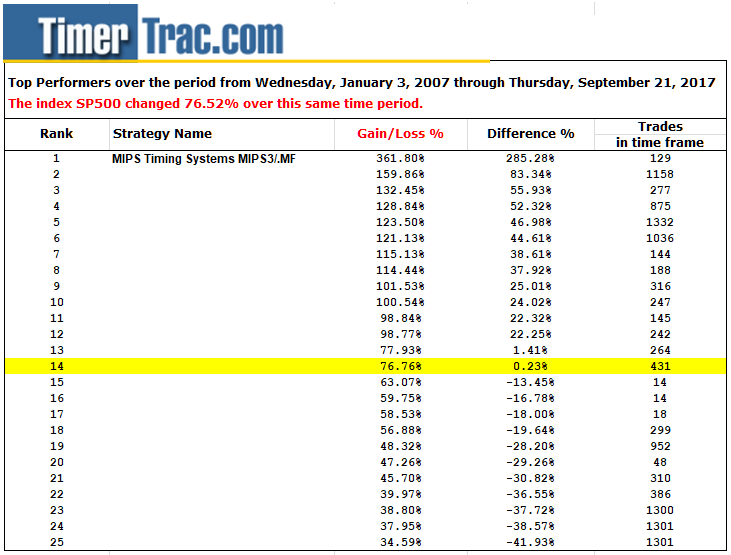
|